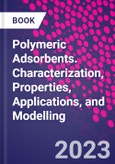Polymeric Adsorbents: Characterization, Properties, Applications, and Modelling offers comprehensive information on the various types of polymeric adsorbents and uses, enabling the reader to understand, identify and prepare adsorbents with the required structure and properties for a range of key industrial applications. The book presents the various types of polymeric adsorbents and their characteristics, focuses on physicochemical properties, synthesis methods, functionalization, and composites and hybrid materials, and highlights key application areas, including gas adsorption, heavy metal removal, hazardous dye removal, and adsorption of antibiotics. Finally, the book provides detailed guidance on modeling of polymeric adsorbent behavior and molecular dynamic (MD) simulation.
This is a valuable resource to researchers and advanced students across polymer science, chemistry, materials science, engineering, environmental science, and engineers, scientists, and R&D professionals with an interest in polymeric adsorbents for industrial applications.
Please Note: This is an On Demand product, delivery may take up to 11 working days after payment has been received.
Table of Contents
1. Types of polymeric adsorbents2. Physicochemical properties of polymeric adsorbents
3. Synthesis methods of polymeric adsorbents
4. Functionalization and improvements of polymeric adsorbents
5. Composite and hybrid polymeric adsorbents
6. Polymeric adsorbents for gas adsorption
7. Polymeric adsorbents for heavy metal removal
8. Removal of hazardous dyes
9. Adsorption of antibiotics
10. Modeling of polymeric adsorbent behavior
11. Molecular dynamic (MD) modelling of polymeric adsorbents








